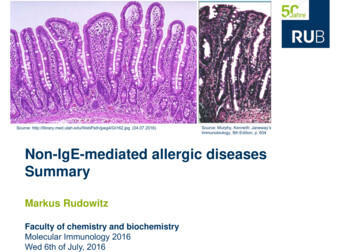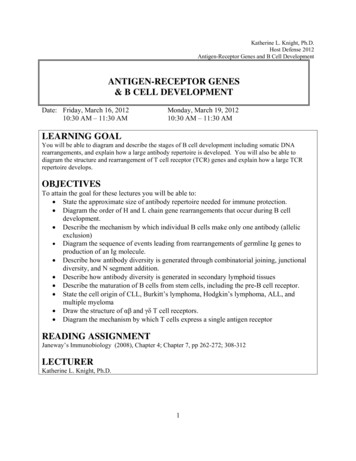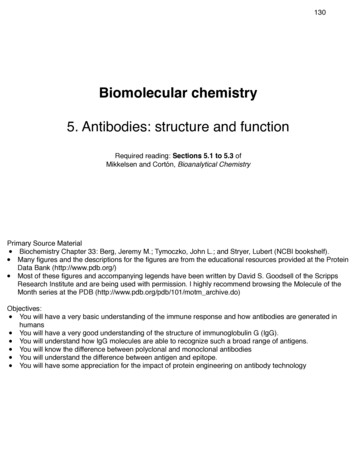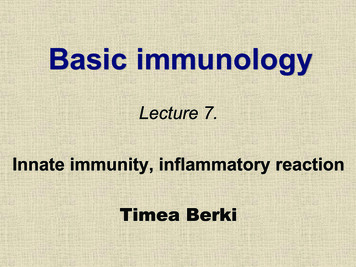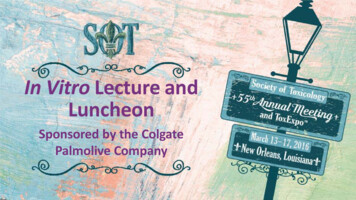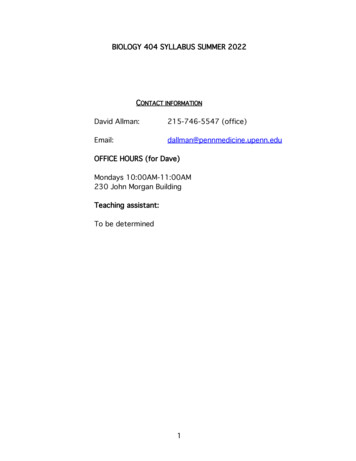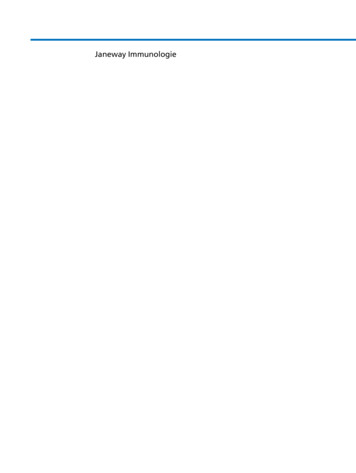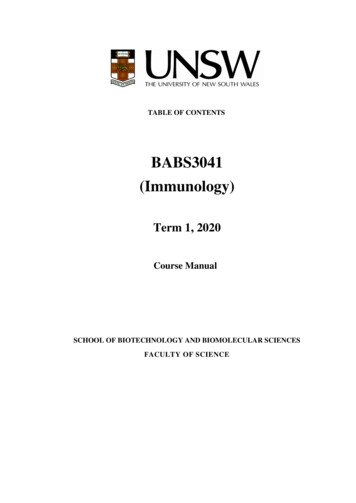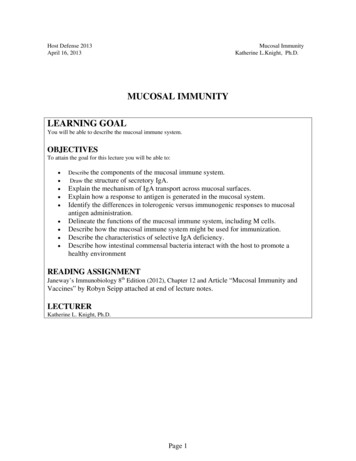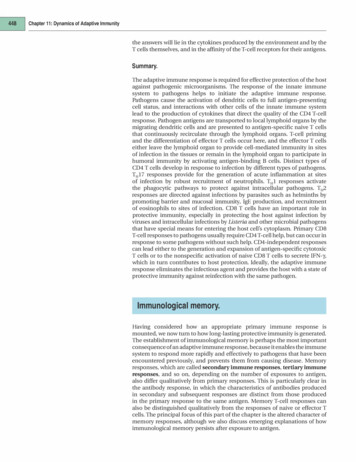
Transcription
Chapter 11: Dynamics of Adaptive Immunitythe answers will lie in the cytokines produced by the environment and by theT cells themselves, and in the affinity of the T-cell receptors for their antigens.Summary.The adaptive immune response is required for effective protection of the hostagainst pathogenic microorganisms. The response of the innate immunesystem to pathogens helps to initiate the adaptive immune response.Pathogens cause the activation of dendritic cells to full antigen-presentingcell status, and interactions with other cells of the innate immune systemlead to the production of cytokines that direct the quality of the CD4 T-cellresponse. Pathogen antigens are transported to local lymphoid organs by themigrating dendritic cells and are presented to antigen-specific naive T cellsthat continuously recirculate through the lymphoid organs. T-cell primingand the differentiation of effector T cells occur here, and the effector T cellseither leave the lymphoid organ to provide cell-mediated immunity in sitesof infection in the tissues or remain in the lymphoid organ to participate inhumoral immunity by activating antigen-binding B cells. Distinct types ofCD4 T cells develop in response to infection by different types of pathogens.TH17 responses provide for the generation of acute inflammation at sitesof infection by robust recruitment of neutrophils. THl responses activatethe phagocytic pathways to protect against intracellular pathogens. TH2responses are directed against infections by parasites such as helminths bypromoting barrier and mucosal immunity, IgE production, and recruitmentof eosinophils to sites of infection. CD8 T cells have an important role inprotective immunity, especially in protecting the host against infection byviruses and intracellular infections by Listeria and other microbial pathogensthat have special means for entering the host cell's cytoplasm. Primary CD8T-cell responses to pathogens usually require CD4 T-cell help, but can occur inresponse to some pathogens without such help. CD4-independent responsescan lead either to the generation and expansion of antigen-specific cytotoxicT cells or to the nonspecific activation of naive CD8 T cells to secrete IFN -y,which in turn contributes to host protection. Ideally, the adaptive immuneresponse eliminates the infectious agent and provides the host with a state ofprotective immunity against reinfection with the same pathogen.Immunological memory.Having considered how an appropriateprimary immune response ismounted, we now turn to how long-lasting protective immunity is generated.The establishment of immunological memory is perhaps the most importantconsequence of an adaptive immune response, because it enables the immunesystem to respond more rapidly and effectively to pathogens that have beenencountered previously, and prevents them from causing disease. Memoryresponses, which are called secondary immune responses, tertiary immuneresponses, and so on, depending on the number of exposures to antigen,also differ qualitatively from primary responses. This is particularly clear inthe antibody response, in which the characteristics of antibodies producedin secondary and subsequent responses are distinct from those producedin the primary response to the same antigen. Memory T-cell responses canalso be distinguished qualitatively from the responses of naive or effector Tcells. The principal focus of this part of the chapter is the altered character ofmemory responses, although we also discuss emerging explanations of howimmunological memory persists after exposure to antigen.
Immunological memory11-13 Immunological memory is long-lived after infection or vaccination.Most children in developed countries are now vaccinated against measlesvirus; before vaccination was widespread, most were naturally exposed to thisvirus and developed an acute, unpleasant, and potentially dangerous illness.Whether through vaccination or infection, children exposed to the virusacquire long-term protection from measles, lasting for most people for thewhole of their life. The same is true of many other acute infectious diseases(see Chapter 16): this state of protection is a consequence of immunologicalmemory.The basis of immunological memory has been hard to explore experimentally.Although the phenomenon was first recorded by the ancient Greeks and hasbeen exploited routinely in vaccination programs for more than 200 years, itis only now becoming clear that this memory reflects a small population ofspecialized memory cells formed during the adaptive immune response thatcan persist in the absence of the antigen that originally induced them. Thismechanism of maintaining memory is consistent with the finding that onlyindividuals who were themselves previously exposed to a given infectiousagent are immune, and that memory is not dependent on repeated exposureto infection as a result of contacts with other infected individuals. This wasestablished by observations made of populations on remote islands, wherea virus such as measles can cause an epidemic, infecting all people living onthe island at that time, after which the virus disappears for many years. Onreintroduction from outside the island, the virus does not affect the originalpopulation but causes disease in those people born since the first epidemic.Studies have attempted to determine the duration of immunological memoryby evaluating responses in people who received vaccinia, the virus used toimmunize against smallpox (Fig. 11.17). Because smallpox was eradicatedin 1978, it is presumed that their responses represent true immunologicalmemory and are not due to restimulation from time to time by the smallpoxvirus. The study found strong vaccinia-specific CD4 and CD8 T-cell memoryresponses as long as 75 years after the original immunization, and from thestrength of these responses it was estimated that the memory response hadan approximate half-life of between 8 and 15 years. Half-life represents thetime that a response takes to reduce to 50% of its original strength. Titers ofantivirus antibody remained stable, without measurable decline.These findings show that immunological memory need not be maintained byrepeated exposure to infectious virus. Instead, it is likely that memory is sus tained by long-lived antigen-specific lymphocytes that were induced by theoriginal exposure and that persist until a second encounter with the patho gen. Although most of the memory cells are in a resting state, careful studieshave shown that a small percentage of these cells are dividing at any one time.What stimulates this infrequent cell division is unclear, but it is likely thatcytokines produced either constitutively or during antigen-specific immuneAfter smallpox vaccination, antibody levelsshow no significant decline, and T-cellmemory shows a half-life of 8-15 yearsCDS memory0102030Time after vaccination (years)responses directed at other, non-cross-reactive, antigens are responsible. Thenumber of memory cells for a given antigen is highly regulated, remainingpractically constant during the memory phase, which reflects a control mech anism that maintains a balance between cell proliferation and cell death.Fig. 11.17 Antiviral immunity aftersmallpox vaccination is long lived.Immunological memory can be measured experimentally in various ways.Adoptive transfer assays (see Appendix I, Section A-36) of lymphocytes fromanimals immunized with simple, nonliving antigens have been favored forsuch studies, because the antigen cannot proliferate. In these experiments,the existence of memory cells is measured purely in terms of the transfer ofspecific responsiveness from an immunized, or 'primed,' animal to a nonim munized recipient, as tested by a subsequent immunization with the antigen.Animals that received memory cells have a faster and more robust response tobe taken to represent true memory in theBecause smallpox has been eradicated,recall responses measured in peoplewho were vaccinated for smallpox canabsence of reinfection. After smallpoxvaccination, antibody levels show an earlypeak with a period of rapid decay, whichis followed by long-term maintenance thatshows no significant decay. CD4 and CD8T-cell memory is long-lived but graduallydecays, with a half-life in the range8-15 years.
Chapter 11: Dynamics of Adaptive Immunityantigen challenge than do controls that did not receive cells, or that receivedcells from nonimmune donors.Experiments like these have shown that when an animal is first immunizedwith a protein antigen, functional helper T-cell memory against that anti gen appears abruptly and reaches a maximum after 5 days or so. Functionalantigen-specific B-cell memory appears some days later, then enters a phaseof proliferation and selection in lymphoid tissue. By 1 month after immuni zation, memory B cells are present at their maximum level. These levels ofmemory cells are then maintained, with little alteration, for the lifetime ofthe animal. It is important to recognize that the functional memory elicitedin these experiments can be due to the precursors of memory cells as well asthe memory cells themselves. These precursors are probably activated T cellsand B cells, some of whose progeny will later differentiate into memory cells.Thus, precursors to memory can appear very shortly after immunization,even though resting memory-type lymphocytes may not yet have developed.In the following sections we look in more detail at the changes that occur inlymphocytes after antigen priming that lead to the development of restingmemory lymphocytes, and discuss the mechanisms that might account forthese changes.11-14 Memory B-cell responses differ in several ways from those ofnaive B cells.Immunological memory in B cells can be examined quite conveniently in vitroby isolating B cells from immunized or unimmunized mice and restimulatingthem with antigen in the presence of helper T cells specific for the sameantigen (Fig. 11.18). B cells from immunized mice produce responses thatdiffer both quantitatively and qualitatively compared with naive B cellsfrom unimmunized mice. B cells that respond to the antigen increase infrequency by up to 100- fold after their initial priming in the primary immuneFig. 11.18 The generation of secondaryantibody responses from memoryB cells is distinct from the generationof the primary antibody response.These responses can be studied andcompared by isolating B cells fromimmunized and unimmunized donormice, and stimulating them in culture inthe presence of antigen-specific effectorresponse, and, as a result of the process of affinity maturation (see Section10-8), produce antibody of higher affinity than unprimed B lymphocytes.The response observed from immunized mice is due to memory B cells,which we introduced in Section 11-9 as B cells that arise from the germinalcenter reaction. These cells populate the spleen and lymph nodes as well ascirculating through the blood, and express some markers that distinguishthem from naive B cells and plasma cells. In the human, a marker of memoryB cells is CD27, a member of the TNF receptor family that is also expressedT cells. The primary response usuallyby naive T cells and binds the TNF-family ligand CD70, which is expressed byconsists of antibody molecules made bydendritic cells (see Section 9-13).plasma cells derived from a quite diversepopulation of precursor B cells specific fordifferent epitopes of the antigen and withreceptors with a range of affinities for theantigen. The antibodies are of relativelySource of B cellslow affinity overall, with few somaticmutations. The secondary responsederives from a far more limited populationUnimmunized donorPrimary responseImmunized donorSecondary responseFrequency of antigen·specificB cells1:104- 1:1051:102- 1:103lsotype of antibody producedlgM lgGlgG, lgAAffinity of antibodyLowHighSomatic hypermutationLowHighof high-affinity B cells, which have,however, undergone significant clonalexpansion. Their receptors and antibodiesare of high affinity for the antigen andshow extensive somatic mutation. Theoverall effect is that although there isusually only a 10-100-fold increasein the frequency of activatable B cellsafter priming, the quality of the antibodyresponse is radically altered, in that theseprecursors induce a far more intense andeffective response.
Immunological memoryA primary antibody response is characterized by the initial rapid productionof IgM, accompanied by an IgG response, due to class switching, which lagsslightly behind it (Fig. 11.19). The secondary antibody response is character ized in its first few days by the production of relatively small amounts of IgMantibody and much larger amounts of IgG antibody, with some IgA and IgE.At the beginning of the secondary response, the source of these antibodies ismemory B cells that were generated in the primary response and that havealready switched from IgM to another isotypes, and express either IgG, lgA,or IgE on their surface, as well as a somewhat higher level of MHC class IImolecules and B7.1 than is typical of naive B cells. The average affinity ofIgG antibodies increases throughout the primary response and continues toincrease during the ongoing secondary and subsequent responses (see Fig.11.19). The higher affinity of memory B cells for antigen and their higherlevels of cell-surface MHC class II molecules facilitate antigen uptake andpresentation, which together with an increased expression of co-stimulatorymolecules allows memory B cells to initiate their crucial interactions withhelper T cells at lower doses of antigen than do naive B cells. This meansthat B-cell differentiation and antibody production start earlier after antigenstimulation than in the primary response. The secondary response ischaracterized by a more vigorous and earlier generation of plasma cells thanin the primary response, thus accounting for the almost immediate abundantproduction oflgG (see Fig. 11.19).The antibodies made in primary and secondary responses can be clearlydistinguished in cases in which the primary response is dominated by anti bodies that are closely related to each other and show little somatic hyper mutation. This occurs in some inbred mouse strains in which certain haptensare recognized by a limited set of naive B cells. For example, in C57BL/6mice, antibodies against the hapten nitrophenol (NP) are encoded by thesame VH (VH186.2) and VL (AI) genes in all animals of the strain. As a result ofthis uniformity in the primary response, changes in the antibody moleculesproduced in secondary responses to the same antigens are easy to observe.These differences include not only numerous somatic hypermutations inantibodies containing the dominant V regions (see Fig. 5.24) but also theaddition of antibodies containing VH and VL gene segments not detectedin the primary response. These are thought to derive from B cells that wereactivated at low frequency during the primary response, and thus were notdetected, and which differentiated into memory B cells.Antibody level10,000'E""2::1000100c:010 cQ) . c:0(.)0.10.01Antibody affinity109108IE.z:.10'·c 1064 56 &immunizationTime after immunization (weeks)Fig. 11.19 Both the affinity and theamount of antibody increase withrepeated immunization. The upperpanel shows the increase in antibodyconcentration with time after a primary(1 ),followed by a secondarytertiary(3 ),(2 ) and aimmunization; the lower panelshows the increase in the affinity of theantibodies (affinity maturation). Affinitymaturation is seen largely in igG antibody(as well as in lgA and lgE, which are notshown) coming from mature 8 cells thathave undergone isotype switching and11-15 Repeated immunization leads to increasing affinity of antibody due tosomatic hypermutation and selection by antigen in germinal centers.somatic hypermutation to yield higher affinity antibodies. The blue shadingrepresents lgM on its own; the yellowshading lgG, and the green shading theIn secondary and subsequent immune responses, any antibodies persistingfrom previous responses are immediately available to bind the newly intro duced pathogen. These antibodies divert the antigen to phagocytes fordegradation and disposal (see Section 10-22), and if there is sufficient anti body to clear or inactivate the pathogen completely, it is possible that nosecondary immune response will ensue. If the levels of pathogen overwhelmthe amount of circulating antibody, excess antigens will bind to receptors onB cells and initiate a secondary B-cell response in the peripheral lymphoidorgans. B cells with the highest avidity for antigen are the first to be recruitedinto this secondary response, and so memory B cells, which have already beenselected for their avidity to antigen, make up a substantial part of the cells thatcontribute to the secondary response.Secondary B-cell responses begin with the proliferation of B cells and T cellsat the interface between the T-cell and B-cell zones, as in primary responses.Memory T cells reside in lymphoid tissues, but can also enter nonlymphoidtissues (see Section 11-6). Memory B cells, in contrast, continue to recirculatepresence of both lgG and lgM. Althoughsome affinity maturation occurs in theprimary antibody response, most arisesin later responses to repeated antigeninjections. Note that these graphs are ona logarithmic scale; it would otherwisebe impossible to represent the overallincrease of around a million-fold in theconcentration of specific lgG antibodyfrom its initial level.
Chapter 11: Dynamics of Adaptive ImmunityPrimary response; KA 1o& M""1through the same secondary lymphoid compartments as naive B cells, prin cipally the follicles of the spleen, lymph nodes, and the Peyer's patches of thegut mucosa. Memory B cells that have picked up antigen are able to presentpeptide:MHC class II complexes to their cognate helper T cells surround ing the follicle. Contact between the antigen-presenting B cells and helperT cells leads to the rapid proliferation of both the B cells and T cells. As thehigher-affinity memory B cells compete most effectively for antigen, theseB cells are most efficiently stimulated in the secondary immune response.Secondary response; KA 107 M""1Reactivated B cells that have not yet undergone differentiation into plasmacells migrate into the follicle and become germinal center B cells. There,they enter a second round of proliferation, during which the DNA encodingtheir immunoglobulin V domains undergoes somatic hypermutation, beforedifferentiating into antibody-secreting plasma cells (see Section 10-8). Theaffinity of the antibodies produced rises progressively and rapidly, because Bcells with the highest-affinity antigen receptors produced by somatic hyper mutation bind antigen most efficiently, and will be selected to proliferate bytheir interactions with antigen-specific helper T cells in the germinal centerTertiary response; KA 1o& M""1(Fig. 11.20).Memory B cells may not produce all antibodies in the secondary response. Onsecondary exposure to antigen, preexisting antibody can sometimes permitthe formation of immune complexes, which do not form immediately in theprimary response. Recent studies have shown that such immune complexescan bind to and activate signaling by Fe receptors on antigen-specific naiveB cells, which acts to accelerate their kinetics of response. The formation ofimmune complexes, however, requires equivalent levels of antigen and anti body, which may not always occur, for example if antibody is present in greatFig. 11.20 The mechanism of affinitymaturation in an antibody response.At the beginning of a primary response,B cells with receptors of a wide varietyof affinities(KA),most of which willexcess. Still, the shorter lag phase in antibody production in the secondaryresponse may arise not only from the faster intrinsic responses of memoryB cells, but also from accelerated naive B-cell responses if antigen:antibodycomplexes can form.bind antigen with low affinity, take upantigen, present it to helper T cells, andbecome activated to produce antibodyof varying and relatively low affinity (toppanel). These antibodies then bind andclear antigen, so that only those B cells11-16 MemoryT cells are increased in frequency compared with naiveT cells specific for the same antigen, and have distinct activationrequirements and cell-surface proteins that distinguish them fromeffectorT cells.with receptors of the highest affinitycan continue to capture antigen andBecause the T-cell receptor does not undergo class switching or somaticinteract effectively with helper T cells.hypermutation, it is not as easy to identify a memory T cell unequivocally asSuch B cells will therefore be selectedto undergo further expansion and clonaldifferentiation, and the antibodies theyproduce will dominate a secondaryit is to identify a memory B cell. After immunization, the number of T cellsreactive to a given antigen increases markedly as effectorT cells are produced,and then falls back to persist at a level 100-1000-fold above the initialresponse (middle panel). These higher frequency for the rest of the life of the animal or person (Fig. 11.21). Theseaffinity antibodies will in turn competepersisting cells are designated memoryT cells. They are long-lived cells with afor antigen and select for the activationof B cells bearing receptors of stillhigher affinity in the tertiary response(bottom panel).particular set of cell-surface proteins, responses to stimuli, and expression ofgenes that control cell survival. Overall, their cell-surface proteins are similarto those of effector cells, but there are some distinctive differences (Fig. 11.22).In B cells, there is an obvious distinction between effector and memory cells,because effector B cells are terminally differentiated plasma cells that havealready been activated to secrete antibody until they die.A major problem in experiments aimed at establishing the existence ofmemory T cells is that many assays for T-cell effector function take severaldays, during which the putative memory T cells are reinduced to effectorcell status. Thus, assays requiring several days do not distinguish preexistingeffector cells from memoryT cells, because memory cells can acquire effectoractivity during the period of the assay. This problem does not apply tocytotoxic T cells, however, because cytotoxic effector T cells can program atarget cell for lysis in 5 minutes, whereas memory CD8T cells need more time
Immunological memoryFig. 11.21 Generation of memory T cells after a virus infection. After an infection, in100this case a reactivation of latent cytomegalovirus (CMV), the number of T cells specificfor viral antigen increases dramatically and then falls back to give a sustained low level ofmemory T cells. The upper panel shows the numbers ofT cells (orange); the lower panelshows the course of the virus infection (blue), as estimated by the amount of viral DNA inthe blood. Data courtesy of G. Aubert.80:g:.0 .!!:!.than this to be reactivated to become cytotoxic. Thus, their cytotoxic actionswill appear later than those of any preexisting effector cells, even thoughthey can become activated without undergoing DNA synthesis, as shown bystudies conducted in the presence of mitotic inhibitors.60a;(J1(J""'(340Q)a. n:: :2:(.)20Recently it has become possible to track particular clones of antigen-specificCD8 T cells by staining them with tetrameric peptide:MHC complexes (see0Appendix I, Section A-28). It has been found that the number of antigen specific CD8 T cells increases markedly during an infection, and then decreasesby up to 100-fold; nevertheless, this final level is distinctly higher than beforepriming. These cells continue to express some markers characteristic of acti vated cells, such as CD44, but stop expressing other activation markers, suchI E.Q "f§E· 0c: Q):2: (.) Ol gProteinNaiveEffectorMemoryi1 A,0II I I I i!ji!i!ji!50150100T ime (days)CommentsCD44Cell-adhesion moleculeCD45ROModulates T-cell receptor signalingCD45RAModulates T-cell receptor signalingCD62LReceptor for homing to lymph nodeCCR7Chemokine receptor for homingto lymph nodeCD69Early activation antigenBcl-2Promotes cell survivalFig. 11.22 Expression of manyproteins alters when naive T cellsbecome memory T cells. Proteinsthat are differently expressed in naiveT cells, effector T cells, and memorylnterferon--yEffector cytokine; mRNA presentand protein made on activationT cells include adhesion molecules,which govern interactions with antigen presenting cells and endothelial cells;Granzyme BEffector molecule in cell killingchemokine receptors, which affectmigration to lymphoid tissues and sitesFaslEffector molecule in cell killingCD122Part of receptor for IL-15 and IL-2of inflammation; proteins and receptorsthat promote the survival of memory cells;and proteins that are involved in effectorfunctions, such as granzyme B. Somechanges also increase the sensitivity ofthe memoryT cell to antigen stimulation.CD25Part of receptor for IL-2CD127Part of receptor for IL 7cells, but some, such as expression of theLy6CGPI-Iinked proteinas expression of the survival factor Bcl-2,CXCR4Receptor for chemokine CXCL12;controls tissue migrationCCR5Receptor for chemokines CCL3 andCCL4; tissue migrationMany of the changes that occur inmemory T cells are also seen in effectorcell-surface proteins CD25 and CD69, arespecific to effector T cells; others, suchare limited to long-lived memoryT cells.This list represents a general picture thatapplies to both CD4 and CDS T cells inmice and humans, but some details thatmay differ between these sets of cellshave been omitted for simplicity.
Chapter 11: Dynamics of Adaptive Immunityas CD69. In addition they express more Bcl-2, a protein that promotes cellsurvival and may be responsible for the long half-life of memory CDS cells.The a subunit of the IL-7 receptor (IL-7Ra or CD127) may be a good markerfor activatedT cells that will become long-lived memory cells (see Fig. 11.22).Naive T cells express IL-7Ra, but it is rapidly lost upon activation and is notexpressed by most effectorT cells. For example, during the peak of the effectorresponse against lymphocytic choriomeningitis virus (LCMV) in mice, aroundday 7 of the infection, a small population of approximately 5% of CDS effectorT cells expressed high levels ofiL-7Ra. Adoptive transfer of these cells, but notthe effector T cells expressing low levels of IL-7Ra, could provide functionalCDST-cell memory to uninfected mice (Fig. 11.23).This experiment suggeststhat the early maintenance, or the reexpression, of IL-7Ra identifies effec tor CDS T cells that generate memory T cells, although it is still not knownwhether, and how, this process is regulated. Memory T cells are more sensi tive to restimulation by antigen than are naive T cells, and more quickly andmore vigorously produce several cytokines such as IFN-y, TNF-a, and IL-2in response to such stimulation. A similar progression occurs for T cells inhumans after immunization with a vaccine against yellow fever virus.Fig.11.23 Expression of the IL-7receptor (IL-7R) indicates which CDSeffector T cells can generate robustmemory responses. Mice expressing aT-cell receptor (TCR) transgene specificfor a viral antigen from lymphocyticchoriomeningitis virus (LCMV) wereinfected with the virus and effector cellswere collected on day 11. Effector CD8T cells expressing high levels of IL 7R (IL-7Rh1, blue) were separated andtransferred into one group of naive mice,and effector CD8 T cells expressing lowIL-7R (IL7R10, green) were transferredinto another group. Three weeks aftertransfer, the mice were challenged witha bacterium engineered to express theoriginal viral antigen, and the numbers ofresponding transferred T cells (detectedby their expression of the transgenicTCR) were measured at various timesafter challenge. Only the transferredIL-7Rh1 effector cells could generate arobust expansion of CD8 T cells after thesecondary challenge.CD4 T-cell memory has been more difficult to study, in part because theirresponses are smaller than those of CDST cells and also because, until recently,there were no peptide:MHC class II reagents similar to the peptide:MHC classI tetramers. Nevertheless, the transfer and priming of naive T cells carryingT-cell receptor transgenes that give the T cells a known peptide:MHC spe cificity has made it possible to visualize memory CD4 T cells. They appearas a long-lived population of cells that share some surface characteristicsof activated effector T cells but are distinct from effector T cells in that theyrequire additional restimulation before acting on target cells. Changes inthree cell-surface proteins-L-selectin, CD44, and CD45-that occur on theputative memory CD4 T cells after exposure to antigen are particularly sig nificant. L-selectin is lost on most memory CD4 T cells, whereas CD44 lev els are increased on all memoryT cells; these changes contribute to directingthe migration of memory T cells from the blood into the tissues rather thandirectly into lymphoid tissue.The isoform of CD45 changes because of alter native splicing of exons that encode the extracellular domain of CD45, leadingto isoforms, such as CD45RO, that are smaller and more readily associated withthe T-cell receptor and facilitate antigen recognition (see Fig. 11.22). Thesechanges are characteristic of cells that have been activated to become effectorT cells, yet some of the cells on which these changes have occurred have manycharacteristics of resting CD4T cells, suggesting that they represent memoryCD4T cells. Only after reexposure to antigen on an antigen-presenting cell dothey achieve effectorT-cell status and acquire all the characteristics ofT H2 orT H1 cells, secreting IL-4 and IL-5, or IFN-y, respectively.Mice infected with LCMV generate a primary COB response; someeffector cells express high levels of IL-7R, whil
11-13 Immunological memory is long-lived after infection or vaccination. Most children in developed countries are now vaccinated against measles
